Farfisa
Farfisa is a manufacturer of electronics based in Osimo, Italy.[2] The Farfisa brand name is commonly associated with a series of compact electronic organs and later, a series of multi-timbral synthesizers. Today, the Farfisa brand mainly produces intercom systems with the company ACI Farfisa which makes and distributes systems for video intercoms, access control, video surveillance, and home automation.[2][3] The Bontempi group owns the keyboard division Farfisa brand name.[1]
| Industry | Electronics |
|---|---|
| Fate | Music division purchased by Bontempi |
| Founded | 1946 |
| Founder | Silvio Scandalli[1] |
| Headquarters | Osimo, Italy |
| Products |
Historical products:
|
At the height of its production, Farfisa operated three factories to produce instruments in Camerano in the Marche region of Italy. Farfisa also made radios, televisions, and other electronic items. The Farfisa brand name is an acronym for "FAbbriche Riunite di FISArmoniche", which translates to "united factories of accordions".[1]
History
Production
.jpg.webp)
Farfisa began manufacturing electric organs in 1964. Distribution in the U.S. was handled by the Chicago Musical Instrument Company, which also owned Gibson, and the instruments were originally known as CMI organs when introduced there. Unlike combo organs such as the Vox Continental, Farfisa organs have integrated legs, which can be folded up and stored inside its base. The first models produced were the Compact series of organs between 1964 and 1968. The line of FAST (Farfisa All-Silicon Transistorized) organs was launched at the 1968 NAMM show,[4] and production of the Professional series appeared around the same time. Production of combo organs ended in the late 1970s after synthesizers had become more commonplace.[5]
1960s
One of the first rock organists to play and spotlight the Farfisa was Domingo Samudio, known as "Sam the Sham", who with his group The Pharaohs had their first hit "Wooly Bully" in the summer of 1965. In 1966, a Farfisa was prominently heard in "Double Shot (Of My Baby's Love)" recorded by the South Carolina-based group The Swingin' Medallions.
Spooner Oldham, the house organist of Alabama recording studio Muscle Shoals Sound Studio, can be heard playing the Farfisa on numerous southern soul recordings from the 1960s, notably "When a Man Loves a Woman" by Percy Sledge, among many others.
Richard Wright's use of the Farfisa Compact Duo was integral to Pink Floyd's sound, the organ being his main instrument on the albums The Piper at the Gates of Dawn, A Saucerful of Secrets, More and Ummagumma. By 1970, he had started to use a Hammond Organ onstage and alternated between that and the Farfisa, depending on the song.[6] The Farfisa was last used on "Dogs" from Animals, but Wright reintroduced it to his keyboard setup on David Gilmour's 2006 tour, featured on the Pink Floyd song "Echoes".
.jpg.webp)
Sly Stone from Sly and the Family Stone played a Farfisa Professional, as seen at their 1969 Woodstock Festival performance.
Hugh Banton from Van der Graaf Generator originally used the Farfisa Professional, applying his knowledge of electronics and contacts as a former BBC engineer to customise it with a variety of additional effects pedals, including distortion and phasing. The Professional is the only organ used on The Aerosol Grey Machine and The Least We Can Do Is Wave to Each Other, after which he also started using Hammonds. It was retired after the group's 1972 split.[7]
John Paul Jones of Led Zeppelin used a Farfisa on "Dancing Days" from Houses of the Holy, as well as occasionally using a VIP-255 or a Professional model on stage. Another famous recording is the 1970 A Tribute to Jack Johnson by Miles Davis, where Herbie Hancock plays spontaneous licks on a broken Farfisa.
Composer Philip Glass began using Farfisa organs with his ensemble in the late 1960s.
1970s
With the advent of synthesizers, organs such as the classic Farfisa seemed to be headed for obsolescence, but time proved otherwise. In the late 1970s, with older models becoming cheaper, numerous punk rock and New Wave bands (especially those influenced by 1960s garage rock and psychedelia), such as Blondie, The B-52s, Suicide, Squeeze, Human Switchboard, XTC and Talking Heads embraced Farfisas as substitutes for more sophisticated keyboards and synthesizers. Their classic sound, in turn, became a staple on multitimbral instruments, first synthesized, then sampled from the originals.
Numerous songs by the Industrial group Cabaret Voltaire use Farfisa drum machines and organs.[8]
"Crocodile Rock" by Elton John features a Farfisa organ, played by John in a honky-tonk rhythm with carnival-style riffs.
The introduction of the Farfisa into West Africa during the 1960s and 1970s played an important role in evolution of Highlife, Mbalax, and later Afro-rock. This can be heard in the work of seminal acts like K. Frimpong and Monomono.
The Farfisa sound is today used to impart a stereotypical 1960s-retro essence to music. It was a key ingredient to the sound of bands such as Inspiral Carpets and has appeared recently on many albums by contemporary artists. The Farfisa brand name, meanwhile, continues to appear on contemporary MIDI keyboards.
The Italian keyboardist/artist Joey Mauro used various Farfisas (Syntorchestra, Professional, Compact, Deluxe, and VIP) to create sound in his Italo disco songs.
1980s
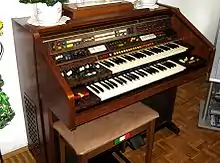
One of Farfisa's most distinctive and expensive organs was the Farfisa Pergamon, which debuted in 1981. Due to its weight of over 200 kilograms (440 lb), the Pergamon didn't have a portable version.
1990s
The Post-rock group Stereolab used various Farfisa organs extensively throughout their career. They were also used by Candida Doyle of the Sheffield group Pulp. A Farfisa was used on Mike Watt's "Against the 70's", played by former Nirvana bassist, Krist Novoselic.
after 1990s
The rock group Green Day used a Farfisa organ on the song "Misery" from the album Warning, played by their bassist Mike Dirnt.[9]
Series
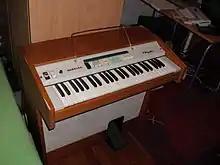
Compact Series (1964–1969)
The Compact series had four models. On the Compact Duo dual manual organs, tone and volume were regulated by controls on the F/AR combination preamp, reverb and power supply unit. On most other models the tone controls and a bass section volume were located on an indented panel on the rear of the keyboard. Underneath the keyboards, a knee-high lever could be actuated for the tone boost feature, turned on by rocker levers on the console. All models had reverb except for the mini-compact. Optional feature: 13-note bass pedals (not for the mini-compact).[10]
Mini-compact
The Mini-Compact is the smallest of the Compact Series. It has only four octaves, with no bass on the early models. The later version had a selector switch to choose bass or high sound in the lowest octave; these models had grey naturals with white sharps in the bass octave. Some of these extended bass models have only three voices (sounds), while the later models had six voices.[11]
- Tan/black Tolex
- Early model (Mini Compact, Mini Deluxe Compact) had three tone switches: dolce, principale, strings
- Late model (Mini Deluxe I Compact): 16' bass; 8' flute, oboe, strings; 4' flute and strings
- Three organ footages: 16', 8', 4'
- Multi-tone booster with knee trigger (also served as expression control).
- 1/4" headphone output
- Swell (expression) pedal (optional)
- Removable legs which stored inside bottom cover (all other models have folding/pivoting non-removable legs)
- Solid State Preamp
The model was used by Mike Mills (R.E.M.), Kate Radley of Spiritualized and by Steve Reich in his piece Four Organs.
Early Compact (Combo Compact)
_live_at_NBI.jpg.webp)


Features:
- Red/black or grey/black Tolex
- One octave of bass with inverse key colors.
- 16' bass, strings
- 8' flute, oboe, trumpet, strings
- 4' flute, piccolo, strings
- 4 vibrato settings
- 3 reverb settings
- 3 rockers for bass volume
- Multi-tone booster
- Swell (expression) pedal
- 1/4" headphone output
- Tube preamp (2 12AX7s) and real spring reverb
- 1/4" bass optional output
- Independent bass and treble 1/4" outputs
- Back panel adjustments for treble and bass tone as well as bass output volume
Late COMPACT (COMBO COMPACT I)
Features:
- Same as Early Combo Compact except:
- Two inferior octaves (one black/white, one grey/white) on the left-hand side of the keyboard; one set of octaves were switch-controllable for choice of a bass or acute sound with bass note sustain and controllable bass percussion.
- Volume balance control between bass and treble on the front panel (trim pot as opposed to rockers of the earlier version)
- Sharp and Soft sound for the manual bass
- Only backpanel adjustment is for bass output.
Compact Deluxe
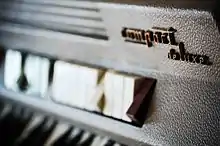
.jpg.webp)
Features:
- Tan/black tolex
- Two inferior octaves (one black/white, one grey/white) on the left-hand side of the keyboard; one set of octaves were switch-controllable for choice of a bass or high sound.
- Bass note sustain and soft/sharp controls.
- Independent controllable percussion for both bass and treble manuals.
- 16' bass, strings
- 8' flute, oboe, trumpet, strings
- 4' flute, piccolo, strings
- 2-2/3' with independent "brilliant" tab
- 4 vibrato settings
- Tube preamp (2 12AX7s) and real spring reverb
- 3 reverb settings
- Multi-tone booster
- Swell (expression) pedal + knee control for multi-tone booster
- Independent bass and treble 1/4" outputs
- 1/4" headphone output
- Late models (Combo Deluxe Compact I) also includes a rhythm section (drum machine) of brush cymbal and drum
Compact duo
_-_Expo_Pink_Floyd.jpg.webp)
Most renowned of the Compact Series, having been used by Rick Wright (Pink Floyd), Stereolab, Al Kooper (Blues Project), Michael MacNeil (Simple Minds), Keith Emerson (ELP), and Clint Boon (The Inspiral Carpets).[12]
Features:
- Grey/Black Tolex
- Four-octave upper keyboard with 9 selectors: 16' Bass, Strings; 8' Flute, Oboe, Trumpet, Strings; 4' Flute, Strings; 2-2/3' (Flute), Brilliance
- Four-octave lower keyboard with three selectors: Dolce, Principale, Ottava.
- Two inferior octaves on the left-hand side of the lower keyboard; one octave was switch-controllable for choice of a bass or acute sound.
- 4 vibrato settings
- 3 reverb settings
- Multi-Tone Booster
- Swell (expression) pedal + knee control for Multi-Tone Booster
- Bass note volume control, sustain, sharp, and percussion.
- 1/4" Bass output
- Lower manual volume control
- Brilliance control which only works with the 2-2/3 (Flute) Tab.
- Later models also incorporate tremolo, percussion and repeat functions for both the upper and lower treble manuals independently.
- Unlike other Compact series organs, the Compact Duo models require a separate power supply/solid-state preamp/real spring reverb unit (called the Farfisa F/AR), to which the organ connects via a multi-lead cable. The American version used a 7-pin Amphenol connector, while European models used a 16-pin bakelite (Hirschmann MES 160). Treble output is available only via the F/AR. Farfisa Amplifier Models BR80 or Twin 80 accept the 7-pin connector and power the organ, allowing the Compact Duo to operate directly, without the F/AR; Farfisa Amplifier Models TR60 accepts the Multipin connector and powers the organ, allowing the Compact Duo to operate directly, without the F/AR. Rocker switches on the organ activate the reverb in the amplifiers (a TelRay (Adineko) reverb/echo unit (oilcan) built into the speaker cabinet).
FAST Series (1968–1971)
The FAST (Farfisa All Silicon Transistor) Series models had a metal cabinet covered with a washable skin plate and plastic edges, chrome folding legs, retractable carrying handles, and a removable music rack. This model of Farfisa was used by Philip Glass on some of his early recordings. This series had the combo organs (FAST 2,3,4,5,Console), and the Professional (Original, Duo, and Pianos)
Fast 2
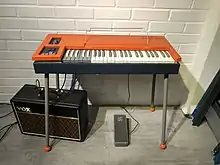
Features:
- Keyboard: 49 notes (C to C)
- Manual Bass: 12 notes (lowest C to C)
- Voice Stops (4): Flute, Clarinet, Reed,Strings
- Vibrato Stops: On/off, Fast/slow
- Manual Bass: Dedicated knob for bass output
- Swell Pedal: Optional, the same socket can be used for external bass output
Fast 3
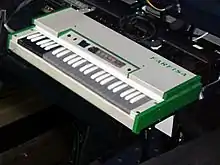
Features:
- Keyboard: 49 notes (C to C)
- Manual Bass: 12 notes (C to B)
- Voice Stops (7): Bass, Clarinet, Flute (8'), Oboe, Trumpet, Strings, Flute (4')
- Vibrato Stops: On/off, Fast/slow
- Manual Bass Selector: Bass/treble, Piano/forte
- Swell pedal: Optional
Fast 4
Features:
- Keyboard: 61 notes
- Voice Stops (8): Bass, Bass Clarinet, Flute (8'), Oboe, Trumpet, Flute, Oboe, Trumpet, Strings, Flute (4'), Piccolo
- Mixture Stops (2)
- Vibrato Stops (3): On/off, Slow/Fast, Light/Heavy
- Percussion Stops (5): Manual bass on/off, Treble on/off, Long/short, Mixture on/off, Mixture soft/sharp
- Manual Bass Selector: Bass/treble
- Pedal and Manual Bass Sound: Soft/Sharp
- FAST 4 has been used by Philip Glass
Fast 5
_at_Troubadour_2010-01-14.jpg.webp)
Features, same as FAST 4, plus:
- Sustain Stops (3): Celesta, Clavicord, Kinura
Artists:
- FAST 5 used by Ronnie Rancifer (Jackson 5) and The Black Keys.
Professional Series (1968 - 1975)
_combo_organ_(by_GigNroll.com).jpg.webp)
(probably PP/222)
Notable artists: Candida Doyle (Pulp), The Ventures (seen on Hawaii Five-O clip), Irmin Schmidt (Can) Laurent Sinclair of (Taxi Girl),
These are the most sophisticated models made by Farfisa. In 1972 Leir Siegler and started producing VIP models and custom models.
- Professional (PP/222 and PP/221): The original single keyboard organ with gray keys. There are two models, with and without foot pedals. Used by Sylvester Stewart (of Sly and the Family Stone). Also by Sun Ra, Tangerine Dream, Jean-Michel Jarre, Kevin Ayers, François de Roubaix, Anthony Cedric Vuagniaux, Amon Düül II, Art Neville, and Hugh Banton of Van der Graaf Generator. This model later evolved to the VIP 345 and VIP 370.
- Professional DUO: Double keyboard version with bass pedals and an option (white keys). There are two models. This model later evolved to the VIP 400, VIP 500, and VIP 600.
- Professional Piano - used by Ralf Hutter of Kraftwerk (track Tanzmuzik), Edgar Froese of Tangerine Dream throughout 1975 and Irmin Schmidt of Can. There are two models, and a Super Piano model in a console style with integrated amp and speakers.
During this same time period, Farfisa also produced a line of effect pedals: the Repeat/Volume pedal (in orange), the Wah-Wah/Volume pedal (in green), and the Sferasound pedal (in blue). There was also a high-end amplifier called the 80 or S-80, which came with speaker cabinets, either the Twin-80, or the BR-80.
VIP Series
.jpg.webp)
- VIP 200
- VIP 202
- VIP 205 and 205 r
- VIP 233 used by Göran Fritzon of Swedish group Gyllene Tider, featuring Per Gessle from Roxette.
- VIP 345 (redesigned Professional) used by Susan Dey (in role as Laurie Partridge, The Partridge Family).
- VIP 255 used by John Paul Jones (Led Zeppelin).
- VIP 370 (redesigned VIP345)
- VIP 400 (redesigned Professional DUO) used by Edgar Froese of Tangerine Dream
- VIP 500 (improved VIP 400)
- VIP 600 (improved VIP 500) used by Michael MacNeil (Simple Minds).
Matador
.jpg.webp)
The Farfisa Matador was produced in the early to mid-1970s. It is a compact organ with a built-in speaker and amplifier. Several models of Matador were produced.
- Matador A
- Matador AR
- Matador LR
- Matador M (model 111124) appears in 1972/1973 Farfisa catalogs
- Matador SR
- Matador 80
Syntorchestra
In the mid-1970s Farfisa produced the "Stereo Syntorchestra", with a three octave keyboard, and "mono" and "poli" tone generator sections. The "poli" section has four timbres: Trombone, Trumpet, Piano, and Viola. The mono section is the "synth" part of the machine. It has nine timbres: Tuba, Trombone, Trumpet, Bari Sax, Alto Sax, Bass Flute, Flute, Piccolo, and Violin. This section is monophonic, with a highest note priority. The mono section can be modified by two envelope controls and a wah-wah; there is also a variable portamento. Only one timbre from each section can be used at a time. Each section has a brilliance control, which adds more top end to the sound, and a variable speed vibrato, which has a delay function, for delayed vibrato effects. The Syntorchestra also has separate outputs for each of its two sections. Farfisa also produced two very large organs which incorporated the Syntorchestra at this time, the 259r and 6290r "Maharani" organs.
Some examples of recordings including the Farfisa Syntorchestra are New Age of Earth by Ashra (Manuel Göttsching) and Moondawn by Klaus Schulze (especially the first half of the B-side, "Mindphaser").
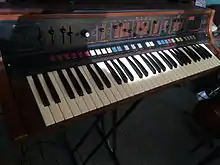
The Syntorchestra was produced at a similar period in the mid-1970s to the more basic String Orchestra, which included piano and string sections. The Soundmaker was Farfisa's next non-organ instrument, with a further development of the synthesizer approach, incorporating string, brass and monosynth sections.
Polychrome
The "Polychrome", built at the end of the 1970s, was Farfisa's largest and most well-featured non-organ instrument, as an analog synthesizer featuring vocal, brass, string, and percussion sections, and including a built in chorus, phaser and modulation as well as aftertouch sensitivity.
Transicord
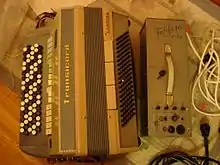
The "Transicord" was a transistor electric accordion. Essentially, it was not a true accordion; an "accordion-shaped combo organ" would have been perhaps a more fitting name. There were no reeds; it was purely electronic. It was designed to be used in conjunction with Farfisa's amplifiers, and had a multi-pin cable that connected the controls of the accordion, with the controls of the amplifier, or the F/AR Reverb preamp power supply unit.
The Transicord came in two models, a "standard" and a "DeLuxe." The standard has one row of stop-tabs similar to those found on a Combo Compact organ, and is reported to have a similar sound. The color scheme was grey with light blue and green. The DeLuxe has two rows of stop-tabs and is black in color.
Opening and closing the bellows reportedly engage an effect similar to the "tone boost" knee lever on Combo Compact model organs. The Transicord can also be equipped with the same volume pedal used for many other Farfisa organs.
Bravo and Commander
Among the last combo organs made by Farfisa were the Bravo and Commander, produced at the end of the 1970s. The Commander reprised part of the design of the VIP 205 in updated form, while the lightweight and simple Bravo's sound was a move to reflect the changing tastes of the time.
See also
- Combo organ
- Hammond organ
- Vox organ
- garage rock
- "Farfisa Beat", a song by Squeeze released in 1980.
References
- "Entry: Farfisa". Archived from the original on 21 August 2012. Retrieved 29 August 2012.
- "ACI FARFISA website". Retrieved 29 August 2012.
- "FARFISA: videocitofonia, telefonia, controllo accessi, sicurezza". www.farfisa.com.
- Vail, Mark (2000). Vintage Synthesizers. Miller Freedman. pp. 276–277. ISBN 0-87930-603-3.
- "Combo Organ Heaven - Farfisa Professional". Retrieved 28 August 2012.
- Mason, Nick (2004). Inside Out - A Personal History of Pink Floyd. Weidenfeld & Nicolson. p. 130. ISBN 0-297-84387-7.
- "The Organs of Hugh Banton". Retrieved 28 August 2012.
- "Cabaret Voltaire - Biography - Amoeba Music". www.amoeba.com.
- "Green Day - Warning:". Discogs.
- "Farfisa: Spinets". Combo Organ Heaven.
- "Combo Organ Heaven : Farfisa Compact - Mini Compact". Retrieved 28 August 2012.
- "Combo Organ Heaven: Farfisa Compact". www.combo-organ.com.
External links
| Wikimedia Commons has media related to Farfisa. |